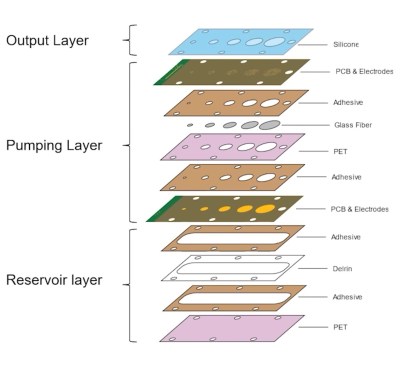If you’re like us, one of the appeals of retro tech is the tactile feedback you get from real buttons. Researchers at Carnegie Mellon have developed a new method for bringing haptic feedback to touchscreen devices.
Using an array of miniaturized electroosmotic pumps, the current prototype devices offer 5 mm of displacement from a 5 mm stackup which is a significant improvement over previous technologies which required a lot more hardware than the displacement provided. When placed under a flexible screen, notifications and other user interactions like the keyboard can raise and lower as desired.
Each layer is processed by laser before assembly and the finished device is self-contained, needing only electrical connections. No need for a series of tubes carrying fluid to make it work. Interaction surfaces have been able to scale from 2-10 mm in diameter with the current work, but do appear to be fixed based on the video (below the break).
You might find applications for haptics in VR or want to build your own Haptic Smart Knob.
















Now this is a fascinating idea. Not exactly what I was expecting for ‘tactile touch’, but I can’t really think of a better description. I was just expecting it to be more like the haptic feed back things like the Steam controller/deck and now many laptop trackpads offer where it is reacting to user input in a tactile way.
Got to wonder what all that inflating and deflating will do to the screens durability, and how reliable the stack will be as that is alot of layers that must remain bonded properly for it to work. But get that sorted (which it seems should be very possible with some practice at the methods) and I can see this being a great option for many things, as really flat featureless screens are pretty terrible as input devices, entirely impossible to use for most tasks without looking – can’t even find the ‘home’ ‘back’ type primary buttons by touch on the sheet of glass properly.
Cars will now have, buttons.
Really don’t see this as a great in car control panel myself, even if it is better that what many brands seem to think is a good idea now – bring back the real switches and dials you can easily reach and set without ever needing to look!
Some brands are seeing the error of their ways: https://slate.com/business/2023/04/cars-buttons-touch-screens-vw-porsche-nissan-hyundai.html
Most switches were removed before airbags became standard.
Those knobs could maul an unrestrained occupant during a collision.
Just use soft rubber buttons…
David Cronenberg would love this stuff.
Yes I Think So
If you want feedback, have the screen give you an electric shock once it has registered the location of your touch.
Even better, have it give you a much bigger shock if you *miss* a button on the screen. That way you will learn to touch the god-given touchscreen accurately.
Or, you’ll just take the tire iron and righteously beat the godforsaken thing to death.
It would certainly cut down the number of hours children will be using their phones!
The same team actually did something similar in the following video:
https://www.youtube.com/watch?v=MHNrQlpstJo
Might be interesting for the blind to use.
I remember this same concept being presented a while ago. I looked it up and the same idea was presented by “Tactus” in 2014. I wonder what changed.
Article: https://ischool.syr.edu/tactile-buttons-on-a-flatscreen-tactus-technology-says-its-real/
Demo video: https://www.youtube.com/watch?v=t4eh-Cn3Pzk
Goosebumps.
One ‘gotcha’ is the use of Propylene Carbonate as the working fluid. As well as not being an off-the-shelf item, it’s a skin irritant and a solvent, not great for an application where your hands are being wiped all over an elastomeric surface. Unfortunately, it is also the reason their setup is more effective than previous setups using DI water was the electrolyte, as the PC can tolerate the higher voltage they use without boiling, which is what allows them to drive higher flow rates and pressures.
Since to use this kind of display, the physical position of buttons is made at design time (it’s not dynamic), I don’t see any advantages compared to a physical switch that’ll cost an order magnitude less, have a decent tactile feedback and is reliable. If the “whaoo” effect is required, one can use a PCB coil under the switch and a small magnet in the switch cap to repulse it (raise it) when required.
I assume the long-term goal would be to decrease pixel (pump) size to something more manageable for interactive elements? That said, I’d take it only in the shape of a keyboard as a drastic improvement on typing on glass.